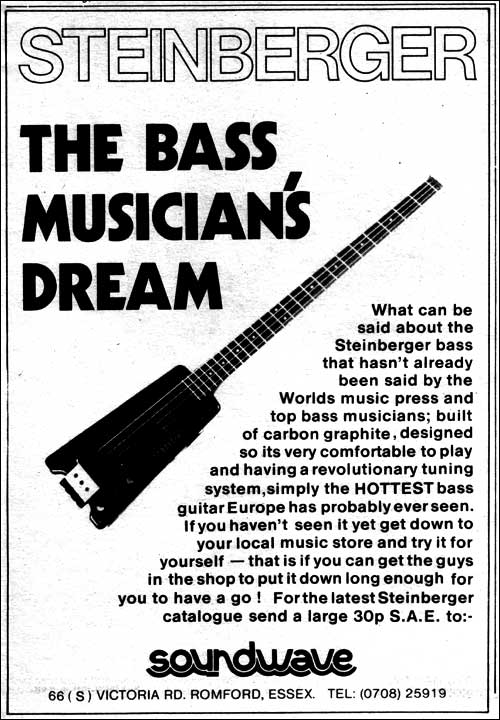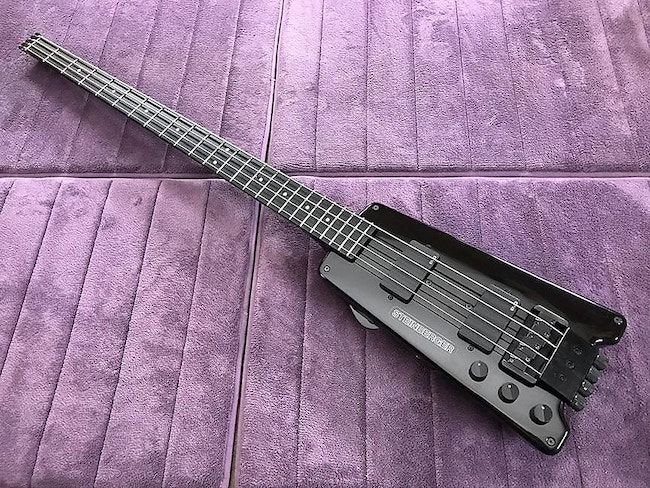On September 3, 1982, Sting, Andy Summers, and Stuart Copeland boarded a helicopter in San Bernardino, California on the grounds of the first US Festival. The trio was chartered over a near-100,000-person crowd interspersed in front of the main stage as Oingo Boingo performed in the afternoon. Later that evening, The Police would headline perhaps their biggest show to date at the tail-end of their world tour supporting Ghost in the Machine.

This event was unique for several reasons. The US festival was a detrimental $12 million flop, in addition to a slew of overdoses and an unforgiving 110-degree weekend. It was also a rather unorthodox attempt to extend an olive branch to the Soviet Union during a tense period of the Cold War. But arguably the most memorable moment of the closing act’s performance was Sting’s bass. Slung over the shoulder of his yellow nylon jacket and striped shirt rested a peculiar instrument: a small, carbon-fiber bass guitar missing its headstock.
It was a pivotal moment for the now infamous headless bass—the Steinberger L2 model, specifically, in this case—having breached the mainstream with an endorsement from one of the biggest rock stars of the moment. Sting, known mostly at the time for playing fretless Ibanez models like the MC900, had traded in his main axes for something entirely uncanny—a bass without a headstock, shaped to resemble a small boat oar.
A year or so later, Rush’s Geddy Lee had begun phasing out his iconic Rickenbacker 4001 and ‘72 Fender Jazz Bass for a Steinberger L2. By 1984’s Grace Under Pressure, the two basses had been entirely replaced in favor of the L2. Later in the decade, Tina Weymouth of Talking Heads would sport a L2 in the music video for "[Nothing But] Flowers," and elsewhere on tour during the Little Creatures era, replacing her signature Hofner 500/2 Club Bass. That particular L2 currently hangs in The Rock and Roll Hall of Fame.
The patient invasion of the headless bass into popularity begs several questions: Why would three of rock music’s most innovative bass players retire their mainstays for a guitar so foreign and peculiar? What was the advantage to playing an instrument without a headstock? Or perhaps most importantly, what are its origins? Where did it come from?
To answer, we must look back nearly six decades to the retail boom of the electric bass, where the big bang of a central design flaw would later call for some radical experimentation and lead to a cunning design play that would later capture the imagination of the world.
By 1950, most live music had become bolstered by stronger electronics systems and amplifiers, leaving many bass players to helplessly compete for volume. A bright luthier and entrepreneur named Leo Fender heard the complaints of industry players and decided to spearhead the creation of a portable, electronic, and slickly designed bass guitar, largely modeled from Fender’s Telecaster design. And so, in all of its stoic glory, the electric bass had hit the market, and music changed forever.
By the mid-1970s the use of the electric bass in popular music had drastically evolved. Whereas the initial electric basses were intended to mimic the muted sound of an upright bass, the musical zeitgeist had shifted into a more streamlined, pop-driven sound that called for a brighter bass tone. Players began applying thickly coiled strings and plugging into stronger amplifiers while playing with picks and primitive stompboxes. But many of these "enhancements" brought to the surface an interesting design flaw embedded deep in the framework of the electric bass.

Gene Fields, a research and development employee for Fender Musical Instruments, was tasked in 1975 with eliminating the dead spot—a particular location on the guitar’s neck where the resonant frequency causes specific notes to have a shorter sustain. According to a story printed in Vintage Guitar back in 1997, Fields’ experimentation launched him to unexplored territory, going as far to create a solid aluminum neck and even fastening a clunky C clamp to the headstock for added weight. His results were varied and ultimately unhelpful; the dead spots were simply shifting around the neck, jumping from one fret to the next in an elusive game of cat and mouse.
At the height of his investigation, Fields removed three strings from a stock Precision bass, detached the remaining machine heads and began sawing off the headstock one inch at a time. Each inch of wood removed caused the dead spot to rise up the neck. Fields continued systematically decapitating the headstock until just one inch of wood remained above the neck, drilled a hole at the top of the neck, and strung the bass string upside down so the ball-end was fastened at the top; a clamp was used at the bottom of the bass to tighten the string. Ultimately, in this mangled iteration of a Precision Bass, the dead spot had elevated past the 14th fret—beyond any cause for concern.
Fields had inadvertently invented the world’s first headless guitar, a groundbreaking Fender prototype whose existence was sadly hampered by a timid marketing team resistant to the task of bringing something so radical to the playing field. It was shelved before production, and Gene Fields subsequently held onto it until his death in 2014.
Meanwhile in 1977, Ned Steinberger was making custom furniture and cabinets in the industrial underbelly of Brooklyn when he met fellow woodworker Stuart Spector, a luthier and cofounder of Spector Guitars. Steinberger, keen to expand his design experience, offered to design a new bass for Stuart’s collection, prompting the creation of the elegantly curved, neck-thru-body-constructed NS-1 bass guitar, which remains a popular mainstay in Spector’s canon to this day.

While sourcing unconventional materials to pursue his newfound interest as an instrument designer, Steinberger met engineer Bob Young, who hipped Steinberger to the idea of carbon-fiber. The revelation to create an instrument made from lightweight carbon-fiber dawned on him quite quickly, but unlike the madcap experiments of Gene Fields, Steinberger’s decision to remove the headstock had little to do with the sonic temperament of the instrument and more to do with his desire to design something innovative, ergonomic, and daringly minimalist. After all, Steinberger was a designer at heart, not a luthier—or even a musician at that.
The first prototype Steinberger headless bass was built in 1977, and unlike its sleek, futuristic L-series descendents, the prototype was rather harsh and industrial in its appearance. Nonetheless, Steinberger managed to garner interest in his creation, most notably with Hap Kuffner, cofounder of Mandolin Brothers, who would later convince a begrudging Steinberger to get into the instrument manufacturing business (Ned was interested in simply licensing designs to manufacturers at the time).
Two years later, Steinberger designed the L2 bass and sold several prototypes at the National Association of Music Merchants (NAMM) summer show. The buyers, including bass titans John Entwhistle and Tony Levin, proved to Steinberger that the market extended beyond luthiers and entrepreneurs—bass players were also in play. Thus, Steinberger was awarded a patent for the L2 bass, and Steinberger Sound Corporation was founded a year later in 1980.
1981 proved a momentous year for the headless bass. The L2 was featured at Musikmesse Frankfurt—a dazzling, cutting edge international music industry fair—and captured audiences with its peculiar design. Later in the year, the International Designers Society of America awarded the L2 with the Industrial Designers Excellence Award. By the year’s end, Time Magazine had declared the Steinberger L2 one of the "Five Best Designs of 1981." Fast-forward six months, to the 110-degree scorcher in San Bernardino, California, where Sting wielded his brand new L2 in front of a crowd of 100,000 strong. The headless bass had captured the world’s attention.
Since the peak of its success, Steinberger Sound began production on six-string guitars and other string instruments and eventually sold to Gibson in the late 1980s. Ned Steinberger now makes his own signature NS instruments. Throughout the years, a handful of guitar companies began producing their own lines of headless basses and guitars—Ibanez’s EHB series, the Kiesel Vader series, and a slew of other independent ventures—and many players have taken a turn with their headless counterparts, a list that includes Bill Wyman, Maurice Gibb, Cliff Williams, Fat Mike of NOFX, Curt Smith of Tears for Fears, and Eddie Van Halen.
Be that as it may, the uncanny legacy of the headless bass can be traced back to the workshops of Gene Fields and Ned Steinberger—where imposing sonic frequencies had been subdued and a flash of creativity and innovation turned the design world on its head, resulting in the uncanny headless bass: the anti-hero of the bass world, propelled to the main stage into the sturdy hands of a rock and roll star.
